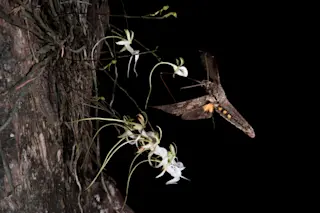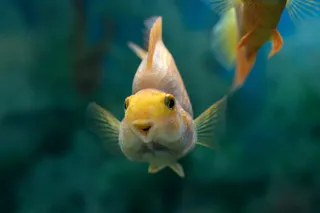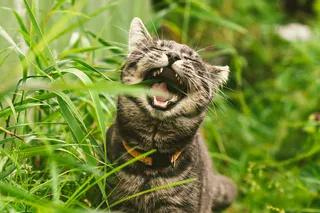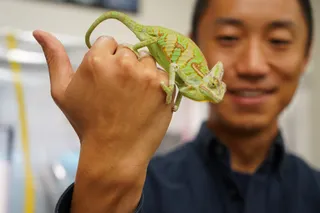Admittedly, there are few circumstances in which a swamp buggy feels like the best choice of vehicle, but on this particular excursion to see one of the rarest orchids on the planet, our monster-truck-sized tires seem comically out of place. Trundling along a dusty, double-track road, we pass through open meadows and airy stands of slash pine (Pinus elliottii) and saw palmetto (Serenoa repens). The faint breeze the vehicle stirs up is so hot and dry, I half expect the straw-yellow grasses along our route to burst into flame.
With every few hundred feet of forward progress, though, we drop an imperceptible inch or two in elevation, moving from the relative highlands of the pine flatwoods toward what some here call “the Grand Canyon of the Everglades:” the Fakahatchee Strand. This 38-kilometer-long (24-mile) stretch of densely forested wetland is one of the lowest points in Florida—albeit by only a few feet—and, as a result, carries much of the fresh water that flows in a slow, meandering path from swamps up north to the state’s southern tip. At least it used to.
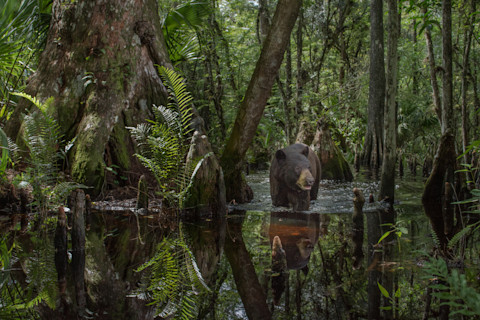
A Florida black bear wades through a cypress swamp on a cattle ranch immediately north of Big Cypress National Preserve. (Credit: Carlton Ward Jr.)
Carlton Ward Jr.
To its proponents, for whom the word “swamp” is no more a pejorative than forest or meadow, the Fakahatchee Strand is not simply a conduit—or, worse, land that is valuable only if drained and developed. It’s a special place, home not just to panthers and bears and river otters, but also to one of the rarest and most famous plants in the world: the ghost orchid (Dendrophylax lindenii). The Fakahatchee is also largely unknown and underappreciated by people in this state and beyond, says photographer Carlton Ward Jr., 43, an eighth-generation Floridian who has made this trek dozens of times in his efforts to document and share the rich biological diversity here. “This is truly the wild heart of the Everglades,” he says, “as wild and inaccessible as you get in the state of Florida.”
Wild as it may be, the Fakahatchee Strand is an ecosystem with a long history of degradation, and one that faces persistent threats. Several of its native species, including the Florida panther (Puma concolor coryi) and ghost orchid, are endangered and clinging to survival in a tiny fraction of the space they once inhabited—space that’s becoming increasingly cut off from other such remnants
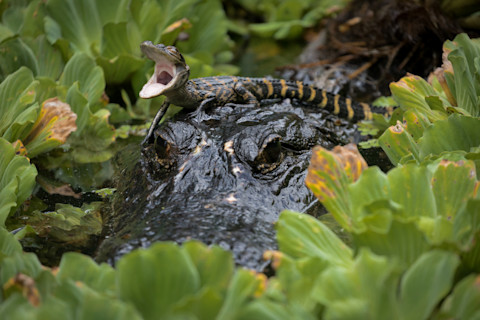
A first-year American alligator finds solid ground on the head of its mother in Corkscrew Swamp Sanctuary. (Credit: Mac Stone)
Mac Stone
With Ward on a bench seat in the back and me riding shotgun, U.S. Fish and Wildlife Service biologist Mark Danaher pilots the swamp buggy toward the deep-green, deciduous tangle ahead. As he drives, he describes some of the many insults that ecosystems here in the Florida Panther National Wildlife Refuge incurred before the land was placed under federal protection in 1989. Most notable was the “cypress era” in the 1950s and 60s, which saw nearly every old-growth cypress tree in the region cut down and removed. Then there was the construction of roads and canals that, to this day, divert and syphon water away from the swamp.
Danaher and other refuge personnel are charged with protecting the native species that remain here, and, to the extent possible, restoring ecosystems to their historical conditions. In other habitats, that might involve prescribed burns, removal of invasive species, and translocating rare, native animals back onto the landscape. Protecting and restoring the refuge’s swampland is different—simpler in some ways, far more complicated and political in others. “It requires very little hands-on management,” Danaher says. “It doesn’t require fire. We don’t have exotic, invasive plant species to contend with. What it needs is good-quality, fresh water flowing through it.”
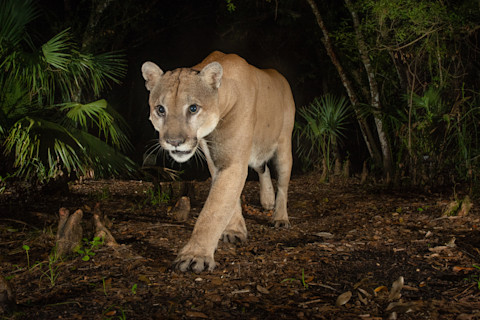
A male Florida panther patrols a cypress swamp at Babcock Ranch State Preserve. (Credit: Carlton Ward Jr.)
Carlton Ward Jr.
But in Florida, where population growth, development, and habitat fragmentation have been the norm for decades, there’s no guarantee that even the reduced flow will continue. Land, even swampland, is a precious commodity in a state that has welcomed on average nearly 900 new residents per day for the past 10 years. And draining swamps is seen as a necessary step by government officials and developers keen to build roads and subdivisions to accommodate all those newcomers.
“That’s why we have to connect the people with the landscape, to ensure that these lands forever stay the best example of true, wild Florida,” Danaher says. And that is precisely what Ward has spent years attempting to do with his photography.
At a bend in the road that turns toward the swamp, Danaher pulls the vehicle off into the weeds and cuts the engine. The three of us climb down onto parched ground, and Ward says with a hint of apology or apprehension, “I’ve never seen it this dry.”
Granted, it’s May and the torrential afternoon rains of summer are due to begin any day, but the observation still sounds ominous coming from someone who knows the swamp so well. Ward has been wading into the Strand’s tannic waters for years, often on a weekly basis, to photograph the ecosystem’s inhabitants and its changing conditions from season to season. Today, we trudge off over ground littered with dry twigs where, on nearly any other visit, Ward would be skimming over the swamp’s surface on a paddleboard.

Carlton Ward Jr. paddles into a remote corner of the Fakahatchee Strand to set up a camera-trap system. During the summers of 2016, 2017, and 2018, Ward racked up 5,000 camera trap hours in his effort to capture the first photograph of a ghost orchid being pollinated. (Credit: Carlton Ward Jr.)
Carlton Ward Jr.
What brought the photographer to the refuge in earnest three years ago was a grant from the National Geographic Foundation to document some of the 200 remaining Florida panthers. It wasn’t long, though, before another, even more elusive, target—one that Ward now calls “the ultimate distraction”—began to occupy his time: the quest to capture an image of the pollinator of the ghost orchid. Long suspected but never confirmed, the identity of the orchid’s pollinator was an unanswered scientific question, and some thought that photographic evidence might help to conserve the endangered plant.
Standing at last in calf-deep water at the base of a pop ash tree (Fraxinus caroliniana), Danaher muses about the passion people have for orchids in general and ghost orchids in particular—passion made famous by the 1998 book The Orchid Thief and the movie Adaptation. Even though he relates to the obsession, the 44-year-old Florida transplant still finds its reach to be surprising. “For god’s sake, they put pictures of ghost orchid flowers on U-haul trucks now,” he marvels.
As he talks, I’m struck by the plant clinging to the tree trunk in front of me. I’m mesmerized not by the orchid’s famed beauty and ethereal qualities, but by its near lifeless appearance. Excited as I am to be standing in the Fakahatchee, gazing at a wild ghost orchid, the truth is, when the plants aren’t in bloom, they’re not much to look at. Which makes it that much more intriguing that Ward, Danaher, and others have placed the ghost orchid alongside the panther as an iconic representative of the swamp—a species with the potential to protect an entire ecosystem.
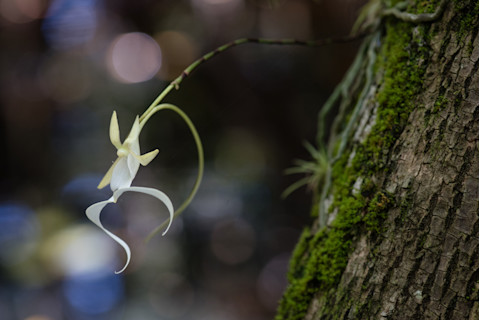
A ghost orchid in the Fakahatchee Strand, within the Florida Panther National Wildlife Refuge. (Credit: Carlton Ward Jr.)
Carlton Ward Jr.
Orchid obsession is, of course, nothing new. The Chinese were cultivating the plants thousands of years ago and publishing books on their care as early as the 13th century. By the mid-1800s, orchid collecting was all the rage in Victorian England, first among wealthy aristocrats—who sent orchid hunters off to the furthest reaches of the planet to gather all they could find—and later among the middle class. Ultimately, the craze would spread to nearly every corner of the world, driving what, today, has become a multi-billion-dollar industry.
Perhaps the most universally celebrated quality of orchids is their astounding diversity of form. Poets, painters, and scientists have all extolled the virtues of that variation, much as Polish naturalist Jakob Breyne did in 1678: “If nature ever showed her playfulness in the formation of plants, this is visible in the most striking way among the orchids,” he wrote. “They take on the form of little birds, of lizards, of insects. They look like a man, like a woman, sometimes like an austere, sinister fighter, sometimes like a clown who excites our laughter.”
Amidst this staggering diversity in a sea of nearly 30,000 orchid species, many specialty collectors seek one quality above all: novelty. For elite orchid lovers, the stranger or rarer a plant is, or the harder it is to cultivate, the more valuable it becomes. The desire to possess what no one else can, has, unfortunately, driven an illicit trade in rare, wild orchids, with tens of thousands of plants traded illegally each year. Individual orchids have sold for as much as $150,000. This demand has placed hundreds of rare species, including the ghost orchid, under tremendous pressure. Aside from habitat loss and degradation, poaching poses one of the greatest threats to ghost orchid survival, and today, only 2,000 to 2,500 wild individuals remain in the United States, with a separate, possibly genetically distinct, small population in Cuba.
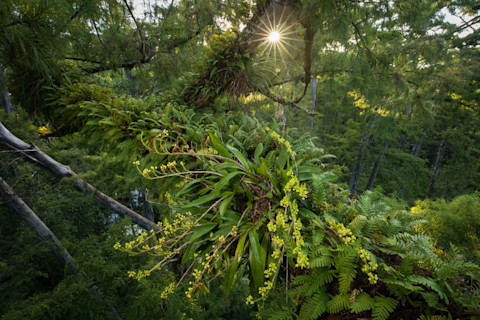
The lush canopies of old-growth cypress in Corkscrew Swamp, Florida provide ideal habitat and microclimates for a number of rare epiphytes, like this yellow helmet orchid. (Credit: Mac Stone)
Mac Stone
Chasing Ghosts
In their quest to identify the pollinator of the ghost orchid for the first time, this team of conservation photographers and scientists spent three summers standing waist-deep in alligator- and snake-laden water, swatting air blackened by mosquitoes, and climbing to sometimes nausea-inducing heights. They came away with an even deeper love for Florida’s wildest wetlands—and with surprising discoveries that may help to conserve both the endangered orchid and its shrinking home.
For scientists, orchids have fueled a different sort of fervor—not a desire to possess, but to understand how the plants’ myriad forms came into being. Despite what early philosophers once thought, or what believers in intelligent design might suggest now, orchid flowers were not shaped by the hand of a divine power. Instead, they arose and diversified under the persistent pressure of natural selection. Each one has its own evolutionary tale to tell, and in nearly every case, sex and the specialized relationships between the plants and their pollinators have played a major role.
One of the best known of these evolutionary stories is that of the star orchid of Madagascar (Angraecum sesquipedale). In 1862, three years after he published On the Origin of Species, Charles Darwin received a package at his home from a British orchid grower. Inside he found a number of plants collected in Madagascar, including one in particular that captured his attention.
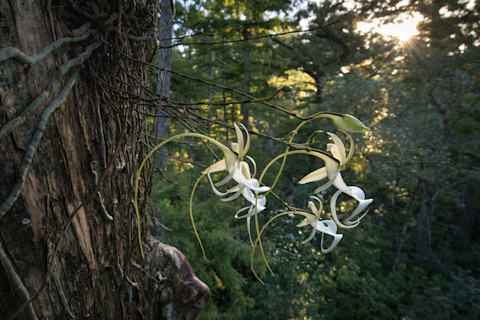
The "super ghost" in Audubon's Corkscrew Swamp Sanctuary is a mass of ghost orchids, perched high in an ancient cypress tree that has produced flowers in every month of the year. Before the cypress forests of the eastern U.S. were logged, many ghost orchids may have bloomed atop these trees. Now, however, only a small tract of old growth cypress swamp remains in Corkscrew. (Credit: Mac Stone)
Mac Stone
As he inspected the strange white orchid with a star-shaped arrangement of fleshy petals, Darwin took note of the flower’s unusually long nectar tube, which measured some 30 centimeters (12 inches) from bloom to tip. Well versed in his own theory of evolution and having seen his fair share of orchids by that time, Darwin began to imagine a potential link between that specialized flower structure and an equally specialized pollinator. He knew, as we know now, that nectar is the reward that plants provide to encourage other organisms to visit and pollinate them. But with the reward hidden so deep within its nectary, the star orchid had created quite the conundrum—for Darwin and any conceivable Malagasy insect.
Although it’s not ranked among his best-known quotes, Darwin ruminated about the star orchid in a letter to a friend, “Good Heavens what insect can suck it?” Then, just days later, he wrote back with an answer to his own question: “… moths with probosces capable of extension to a length of between ten and eleven inches.”
At the time, it was nothing more than a prediction. But then, in 1907, more than 20 years after Darwin’s death, a moth fitting his description was discovered in a rainforest of Madagascar. The insect was quickly dubbed Darwin’s hawkmoth (Xanthopan morganii praedicta), in reference to his now-famous prediction. It would be another 85 years, though, before scientists finally had the photographic evidence to prove that the moth does in fact pollinate the star orchid.
Prior to the summer of 2014, photographer Mac Stone hadn’t given ghost orchids much thought. Sure, he knew of the plants. But, as a native Floridian who, like Ward, had devoted much of his career to connecting people to the wild beauty of his state, he had plenty of other fascinating species to photograph.

Andrei Sourakov, an entomologist at the University of Florida, displays moth specimens from the Museum of Natural History in Gainesville. The giant sphinx moth, the largest moth in the center of the tray, was long thought to be the sole pollinator for the ghost orchid. (Credit: Mac Stone)
Mac Stone
Stone, 35, grew up in north-central Florida’s college town of Gainesville. As a kid, he pedaled his bicycle to local creeks and hammocks to explore the wild places that few visitors or residents ever encounter. In the beginning, the photographs he took with his father’s old film camera mostly served to verify what he said he had seen on those daily adventures. Before long, though, he began to appreciate the power that photography had to enhance a story—and perhaps, to alter its outcome.
When Stone was just 15 years old, a group of property owners asked if he might be willing to help in their bid to protect a local creek from development. While a city council meeting is about the last place an outdoorsy kid would want to spend an afternoon, Stone gave what he describes now as his very first keynote. In the end, the bid to save the creek was only partially successful, but for Stone, the experience made an indelible impression. “Very early on, I saw the power of photography to change minds,” he says
Since that time, Stone has spent the past two decades showcasing not only Florida’s iconic species, but the unique ecosystems in which they live. That’s what brought him to Big Cypress National Preserve, just across State Road 29 from the Florida Panther Refuge, in June of 2014. At the time, he was working on the last few images he needed to complete a book project about the Everglades. And given the ghost orchid’s notoriety, rarity, and reliance on swamps, it was a shot he desperately wanted.
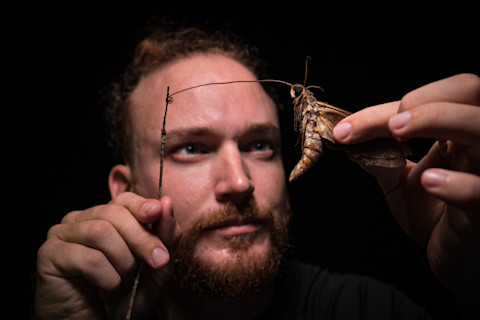
Tropical ecologist Peter Houlihan inspects the proboscis of a giant sphinx moth, a species long believed to be the only pollinator of the ghost orchid. Its proboscis is twice the length of its body, allowing it to access nectar stored deep inside flowers like the ghost orchid and the moonflower. (Credit: Mac Stone)
Mac Stone
Ghost orchids aren’t the types of organisms one just stumbles upon, and these days, the whereabouts of known individuals are generally kept secret. But Stone had contacts at the various refuges in South Florida, and after placing a few calls, eventually found himself wading into Big Cypress swamp with photographer Chris Evans, who knew the area inside out.
The orchids they found that day, Stone’s first, didn’t disappoint. They were in full bloom, dancing in the thick, mosquito-filled air above the tea-colored water. As Stone took pictures, he found himself reflecting on the basics of ghost orchid natural history: the pond apple (Annona glabra) and pop ash trees the plants prefer as hosts; the fact that they’re generally found in clusters, a result of the way their dust-like seeds scatter in the faint breeze; and the role that water in the swamp plays in moderating the temperature of the microhabitats where cold-sensitive ghost orchids live in the event of rare South Florida freezes.
In addition to what Stone already knew about the orchids, Evans shared two additional pieces of information that day that caught Stone’s attention. He noted that on average only 10 percent of ghost orchid plants bloom in any given year, and that, of those, only 10 percent will be pollinated. Evans went on to say that the orchid has only one known pollinator, the giant sphinx moth (Cocytius antaeus)—although, he said, pollination by that species or any other had never been verified. While a 2008 video captured by ghost orchid aficionado Chris Little seemed to show a giant sphinx visiting a ghost orchid, scientists had deemed the footage inconclusive, both in terms of the species of the moth and whether or not it had pollinated the orchid.
On one level, Stone was fascinated purely because of the opportunity to solve a longstanding puzzle. But he also knew that learning more about the ghost orchid’s pollinator could be critical to ongoing efforts to conserve it. Among the many reasons that ghost orchids are struggling to survive and reproduce is that—these days, at least—they rarely produce seed pods. Less than 5 percent of the 2,000 or so known ghost orchids in Florida manage to do so.
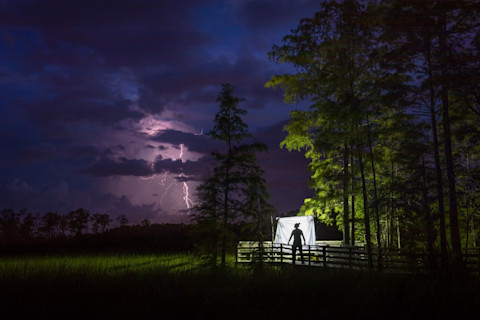
Under the veil of night, ecologist Peter Houlihan inspects a light trap designed to attract nocturnal insects in Corkscrew Swamp. Minutes after this image was captured, a giant sphinx moth flew to the trap, the first time in six years of light trapping that Houlihan managed to attract one. (Credit: Mac Stone)
Mac Stone
“We’re seeing extremely sporadic and low levels of seed pod formation,” says Mike Kane, a University of Florida scientist who leads a project to propagate ghost orchids in captivity and, in collaboration with Danaher’s team, reintroduce them to the wild. While the team has had great success growing ghost orchids in their lab, and while more than half of the young orchids they’ve affixed to swamp trees have survived, their transplants can’t reproduce if they don’t make seed pods. “The big issue is probably pollinators. The pollinators have to be there to pollinate, or it’s not going to happen.”
Inspired by the mystery and mesmerized by the rare plant’s seemingly terrible odds of reproducing in the wild, Stone devised a plan. He remembers calling Ward, who had been a mentor and occasional collaborator over the years, to unveil his approach to capturing the first-ever image of the ghost orchid’s pollinator. He would use remotely operated camera traps, he said, and would sleep out in the swamp for as long as it took.
What he didn’t know at the time was that, like so many other great ideas, this one would find its way onto a back burner until inspiration—and another book project—would put the ghost orchid squarely in his sights once again.
It’s no accident that the stories told about ghost orchid pollination sound so similar to the oft-recited tale of the star orchid and Darwin’s hawkmoth. Like their Malagasy counterparts, ghost orchids also have long nectar tubes—about 13.5 centimeters (5.3 inches) on average—and giant sphinx moths have similarly long tongues. Even so, the confirmation of one specialized relationship does not automatically confirm another a continent away, says tropical ecologist Peter Houlihan, who has studied orchid-pollinator relationships in both Madagascar and South Florida. In Houlihan’s mind, the narrative about Florida’s famous orchid and its pollinator has long been “one of those just-so stories… it sounds nice, and so it is,” he says. But the scientific collections he studied at the Florida Museum of Natural History suggested a more complex story. “It doesn’t take long to realize that there are other hawkmoths in South Florida that have a proboscis length that could pollinate these orchids.”
To test these ideas, rather than simply debate them, Houlihan went to the best place he knew of to catch ghost orchid pollinators in the act: the Fakahatchee Strand. While his expectations of success might not have been overly high when he first entered the swamp in July of 2014, he did so with a good amount of time on his hands and what must have been uncanny resolve and patience.

Under the veil of night, ecologist Peter Houlihan inspects a light trap designed to attract nocturnal insects in Corkscrew Swamp. Minutes after this image was captured, a giant sphinx moth flew to the trap, the first time in six years of light trapping that Houlihan managed to attract one. (Credit: Mac Stone)
Mac Stone
The Everglades in midsummer is, by all accounts, an unrelenting environment. Never mind the waist-deep water, alligators, and poisonous snakes, the heat, humidity, and mosquitoes are, in Houlihan’s understated terms, “impressive.” Despite the challenges, which were magnified by his decision to forgo insect repellent (he didn’t want to deter would-be pollinators as they homed in on the orchid’s scent), Houlihan endured. For 23 long nights, he sat atop a ladder, being eaten alive, waiting to trigger a camera trained on an orchid bloom—desperately hoping a pollinator, any pollinator, would appear from out of the darkness. It never happened.
Clearly, a different strategy would be required to catch the ghost orchid’s pollinator in the act, and Ward, like Stone, thought camera traps were the answer. “Scientists were still trying to unravel this mystery,” says Ward, “and I had the tools to help do it.” In 2016, he took some of the camera traps he had originally intended to use on Florida panthers and started training them on ghost orchids in the Fakahatchee Strand. While his camera traps were a dramatic improvement over Houlihan’s ladder-and-patience approach, they weren’t without their own set of challenges. Capturing a small, fast-flying insect in focus is difficult even in the best of circumstances, let alone at night, with no ability to adjust your framing. And other wildlife often made matters worse.
Once, while setting up one of his camera traps, Ward had to throw a water bottle at an alligator that came far too close for comfort. On another occasion, a dense cloud of mosquitoes became a new kind of annoyance. “I had tremendous trouble getting the orchid to stay still enough for a long exposure,” Ward explained, “because the wing beats of the mosquitoes were creating enough wind that the thing was just kind of dancing around.”
But the biggest challenge Ward faced is that orchids bloom so infrequently and unpredictably. In any given year, most ghost orchids never produce a flower, and those that do usually unfurl just one, two, or three blooms in a seductive, but brief, summer display. Ward’s shots on goal were extremely limited, and he was still figuring out how to adjust his camera traps to deal with the specific challenges of photographing a nocturnal moth. It wasn’t until his third summer of tweaking and mosquito-swatting that his unlikely quest to capture the ghost orchid’s pollinator on film began to show any real signs of a potential payoff. “It’s almost embarrassing to think about how many hours I’ve spent going after such a chance,” he reflects.
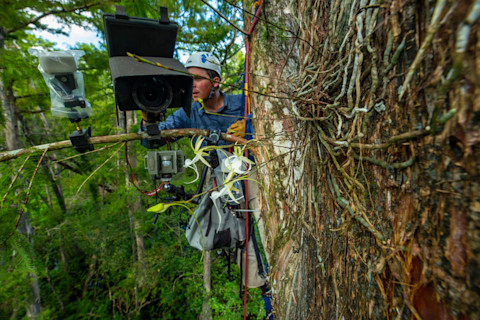
Conservation photographer Mac Stone used a camera trap to capture the first-ever photo of a giant sphinx moth visiting a ghost orchid. His early rig (pictured here) was attached to a tree branch. Later he had a special “treepod” manufactured that could be attached directly to the trunk of the tree. (Credit: Peter Houlihan)
Peter Houlihan
Not far away, in an Audubon Society reserve called Corkscrew Swamp Sanctuary, the odds of success were actually significantly better. There, a ghost orchid exists that is quite unlike any of Ward’s ephemeral subjects. Affectionately dubbed the “super ghost,” this robust plant, which is likely a cluster of three separate orchids, is renowned in orchid circles around the world. While most ghost orchids cling to gnarled trunks of pond apple and pop ash trees just a few feet above the water’s surface, the super ghost is perched 50 feet up on the side of a stately, old bald cypress tree (Taxodium distichum). And while most ghost orchids bloom sporadically, if at all, the super ghost never seems to miss a beat. It has bloomed in every month of the year, although still most heavily during the summer, and has produced as many as 40 flowers in a single year.
In the fall of 2017, Stone was working in the Corkscrew Swamp Sanctuary as part of a new book project on old-growth cypress forests. Hurricane Irma had just hit the area hard, creating a sea of toppled cypress trees covered in epiphytes. “I’m walking around and I’m seeing all of these orchids on canopies that have fallen down, and I started thinking, ‘Well, dang. I should just start climbing some of these,’” says Stone. That’s when he first saw the super ghost up close. Immediately, he dove back into his temporarily shelved goal to photograph the ghost orchid’s pollinator. He couldn’t resist the opportunity to depict how and where ghost orchids might have lived before wide-scale logging decimated the region’s forests.
With its profusion of blooms, Stone believed the super ghost would provide the ideal opportunity to capture pollination in action, and he had plenty of camera trapping experience to bring to the project. He’d just never rigged a camera trap 50 feet in the air before. After doing some initial research, he reached out to Houlihan for advice. Because of his past efforts, Houlihan was intimately familiar with the biology of ghost orchids and their potential pollinators, and he could consult about camera angles and the most likely timing of pollination visits.
Still, it wasn’t easy. “It’s a blessing that there are so many blooms, because it means there are more chemical smells going out, more things to alert potential pollinators that this is in bloom and it has nectar,” says Stone. “But at the same time it’s a curse, because you cannot zero in on something. You cannot say for sure, ‘This bloom will get pollinated, this one has yet to be pollinated.’ You just don’t know.”
For Stone, who now lives in South Carolina, one of the most consuming challenges was the anxiety of setting a camera trap and then walking away, sometimes for days at a time, with no control over what might happen next. “It’s an understatement to say how stressed out I was. I wasn’t sleeping that whole summer,” says Stone. “I’d come home and I would sit there in bed at night and think, ‘Shit, I think I turned the sensor off and I don’t remember turning it back on.’ You know, like you left the iron on or something. But the iron is in another state, and you’re going to lose way more than your house. And so I would book a flight the next day and go unplug my iron.”
Despite the hardships, whether they occurred waist-deep in swamp water or at dizzying heights, all three of them—Houlihan, Ward, and Stone—were determined to stick with it. “There is no easy orchid. There is no easy effort, which is kind of what makes this so exciting,” Stone says now. “For a photographer, the challenge of making the photo is what makes the image and the whole project alluring.”
When Ward paddled into the swamp to check his orchid cameras early last July, he had a pretty good idea what to expect. Camera traps can be triggered by anything from falling raindrops and rustling leaves to buzzing mosquitoes, and that can result in monotonous timelapse sequences of nothing in particular. The ultra-sensitive LIDAR trigger that Ward was using on his ghost orchid traps only made that problem worse.
Balancing atop his paddleboard, Ward settled in as best he could and began to scroll back through the preceding hours and nights, watching as thousands of nearly identical images flashed past the screen on the back of the camera. Then, suddenly, a burst of activity. In back-to-back photos, Ward saw the orchid bounce entirely out of the frame, first down and then up. “I’m like, ‘What in the world is going on?’,” he says. In the next two photos, he sees a little frog, first hanging off of the orchid, and then hunkering down on a leaf below—with a bit of orchid petal in its mouth—after its unsuccessful attempt to catch a spider.
The camera revealed other activity around the orchid that week, too. “You had itty-bitty moths that were just kind of hovering in space. You had medium-sized moths that were actually landing on the flower, but seemingly had no capability to get any nectar.” While these weren’t quite the images Ward was hoping for, they were an inspiring proof of concept that his approach and his equipment were working—and they were beginning to paint a more complete picture of the ghost orchid and, as Ward describes it, “the microcosm that happens around this bloom.

This photo, captured in the summer of 2018, was the first to show a pawpaw sphinx moth probing and likely pollinating a ghost orchid bloom. A pollinium (pollen cluster) from the ghost orchid is visible on the moth's head. (Credit: Carlton Ward Jr.)
Carlton Ward Jr.
The super ghost was starting to produce results, too. Like Ward, Stone had settled in to the routine of checking his camera, often daily in his case, to tweak angles, change batteries, clear spider webs from his lens, and hope that something, anything, had flown into his camera frame, only to find a sea of monotonous flower portraits.
While there was no reason to expect anything different on that mid-July morning, he was always hopeful on his climbs up to check his trap—“like a kid on Christmas morning,” he says. With Houlihan coming up the tree just a few feet behind, Stone reached the camera, opened the back of the waterproof case, and began scrolling through the images. And there it was, like a figment of his imagination, a huge moth nearly filling the camera frame: the giant sphinx. Though the first image he saw was out of focus, Stone recognized the insect in an instant. “I remember my heart jumping,” he says. He had seen countless pictures of them before, but never on one of his cameras, and never in the proximity of a ghost orchid. Indeed, the image was the first of its kind.
It was a triumphant moment, but Stone and Houlihan quickly began to scrutinize every detail about that photo and the handful of other images the camera had captured during the moth’s second-long visit. Stone couldn’t help critiquing the quality of the photos and thinking about how he might adjust his system to do better. But more importantly, they each looked for clues about how the moth had interacted with the orchid, analyzing every detail and trying to infer meaning from what they did or didn’t see in those brief moments in time.
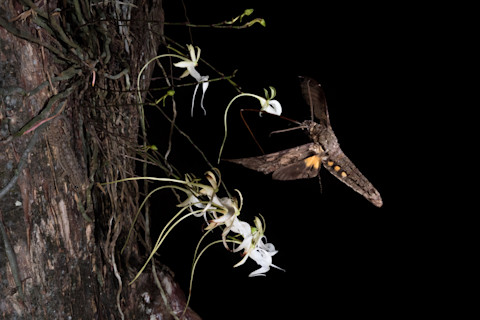
A giant sphinx moth extends its proboscis to drink the nectar from a ghost orchid. (Credit: Mac Stone)
Mac Stone
One thing they noticed is that even while the moth was apparently feeding, with its proboscis deep inside the nectar tube, its head was nowhere near the flower itself. And the orchid’s pollinium, the bright yellow packet of pollen that the flower produces, was nowhere to be seen. Instead, the giant sphinx was dusted with a fine, gray powder, most likely the pollen of a moonflower (Ipomoea alba), another of the swamp’s bright, white blooms, but far more plentiful. While Houlihan was careful not to make sweeping conclusions based on a few still photos, he says that even these early observations suggested a relationship between the ghost orchid and the giant sphinx that is far less specialized than was once suspected.
The results continued. After so many years of disappointment, especially for Houlihan, it felt like things had finally started to click. Both Stone and Ward were getting steady results. The key frames were still few and far between, gems amidst thousands of discards, but, considering the odds that they all knew so well, it was a veritable flood. More often than not, the large moths flooding in were not the giant sphinx moths many people had long suspected.
All told over the course of the summer, during nearly 7,000 camera-trap hours, Ward and Stone documented visits from five different species of large hawkmoth, two of which clearly carried ghost orchid pollinia. One of these, the fig sphinx moth (Pachylia ficus), was practically a regular, showing up at ghost orchids multiple times, both in the Fakahatchee and at Corkscrew, often with ghost orchid pollinia on its head. What’s more, the super ghost and at least two of Ward’s orchids in the Fakahatchee also produced seed pods last summer. “I came back, three or four weeks had passed since those original pictures, and two of the flowers actually had seed pods on them,” Ward says. “We know pollination occurred.”
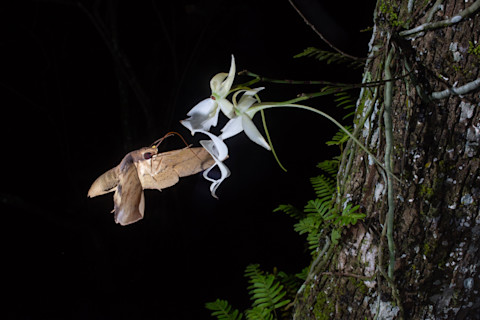
Captured on July 5, 2018, this was the first photograph to document pollination of a ghost orchid bloom. Contrary to the expectations of many experts, who believed that the giant sphinx moth was likely the only pollinator of the ghost orchid, this moth is a fig sphinx. The yellow bundle on its head is a ghost orchid pollinium (pollen cluster). (Credit: Carlton Ward Jr.)
Carlton Ward Jr.
What Houlihan found to be particularly intriguing about these results is that the fig sphinx has a significantly shorter proboscis than the giant sphinx—just 4 centimeters (1.6 inches) compared to the giant sphinx’s 10.1 centimeters (4 inches). Still, it could clearly pollinate the ghost orchid. And Houlihan has identified more than a dozen other moth species in the region that have probosces at least as long as that found on the fig sphinx. As he and coauthors noted in a paper published in Scientific Reports this year, serving multiple pollinators, rather than catering to a single species, may give the few remaining ghost orchids left in the Everglades a better chance of survival.
As for the moths, their survival is at stake, too. Butterfly and moth diversity and abundance both tend to be relatively low in swamp forests globally, and the Everglades is no exception. Here, only three species of flowering plants are known to be pollinated at night by hawkmoths: the ghost orchid, the moonflower, and the Florida swamp lily (Crinium americanum). Given the extreme rarity of the ghost orchid, the other two species are likely important nectar sources for the Everglades’ hawkmoths—meaning that the ghost orchid is dependent not just on its pollinators, but also on healthy populations of these other native plants for its survival
As Houlihan and I discuss the meaning and significance of the team’s results, I’m reminded of my earlier conversation with Mark Danaher, and his hope that the ghost orchid could be a species that saves an entire ecosystem. With these new findings, pointing to interdependencies that are far more complex than scientists previously realized, that possibility feels both more real and more important.
Saving the ghost orchid, this species that captivates admirers around the world, will require more than just propagation and reintroduction efforts. It will require holistic habitat management, including thinking differently about the orchid’s multiple pollinators. “In one of the most rapidly urbanizing states in the nation, people don’t like mosquitoes, and they constantly spray,” says Danaher. “If we don’t keep pollinators in mind, we could lose those critical pollinators that are necessary for ghost orchids to perpetuate themselves.”
It will also require guarding, vigilantly, what little remains of Florida’s wild Everglades. While Ward, Danaher, and I crunched our way through the dry Fakahatchee this spring, Ward received a phone call from a colleague who shared news that Florida Governor Ron DeSantis had just approved a new road proposal that would carve three corridors through the state’s undeveloped areas and undermine Everglades restoration efforts. Ward will be fighting it every step of the way. “We’re in the wildest part of the Everglades, where you have this sanctuary of beauty and inspiration and hope, a glimpse of this primordial world the way it used to be,” says Ward. “But the threats to this place are not right here. The threats are around the edges. When the road-planning discussions begin, I want them to know that the world is watching.”
[This story originally appeared on bioGraphic]


